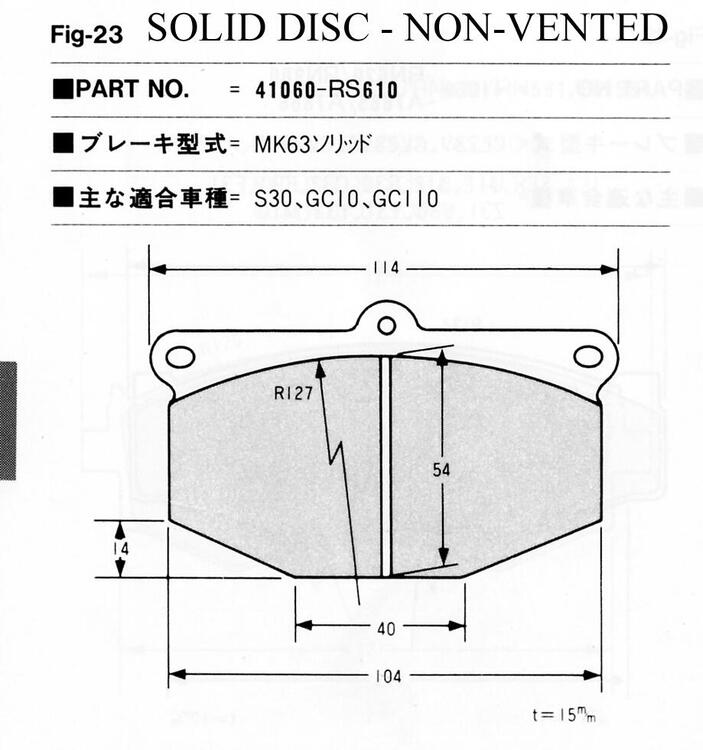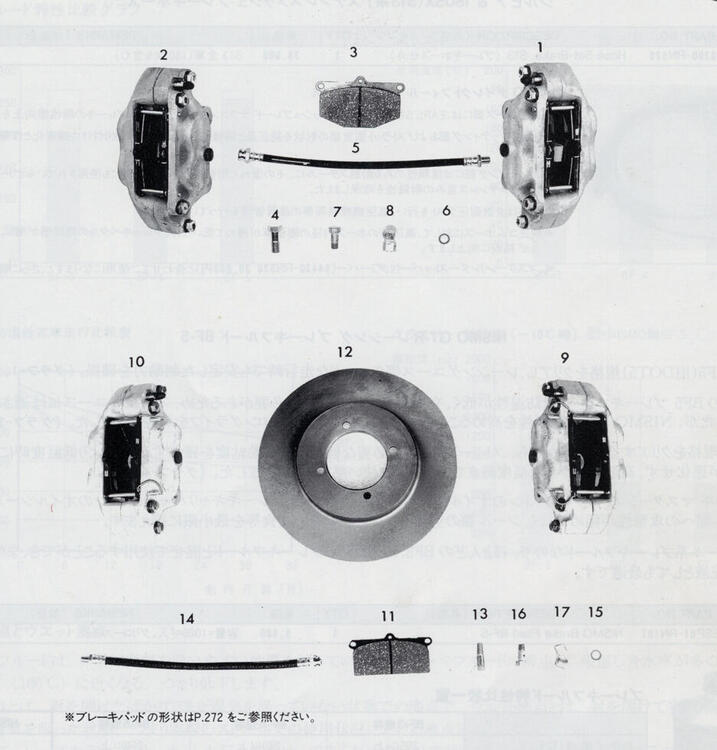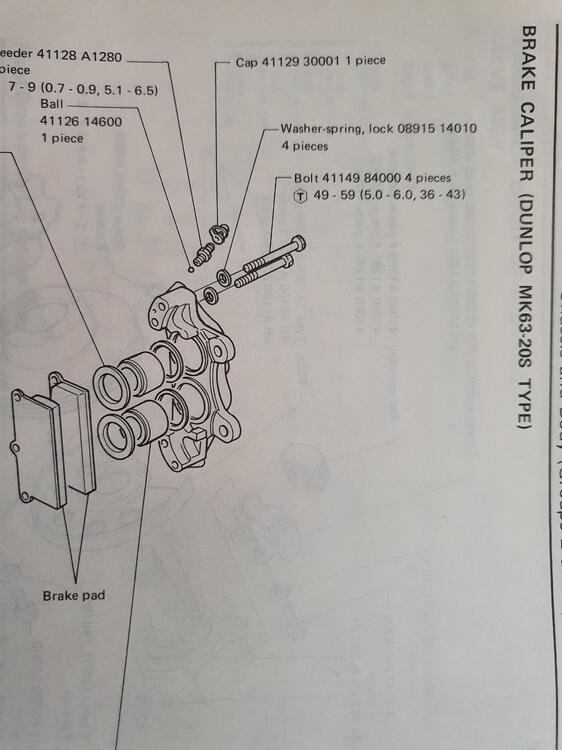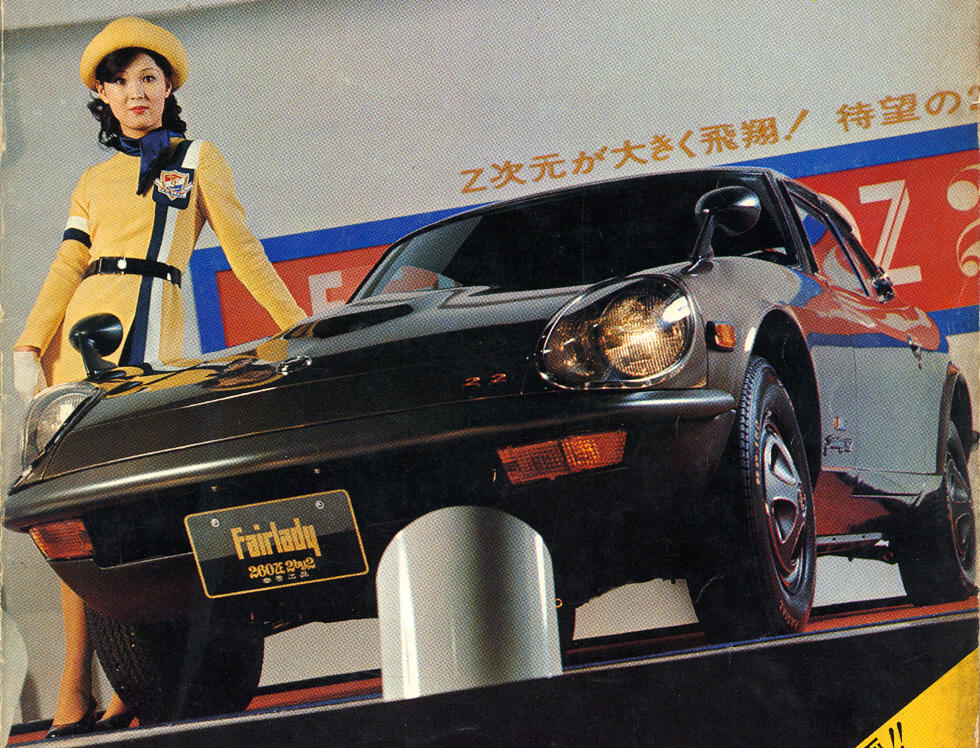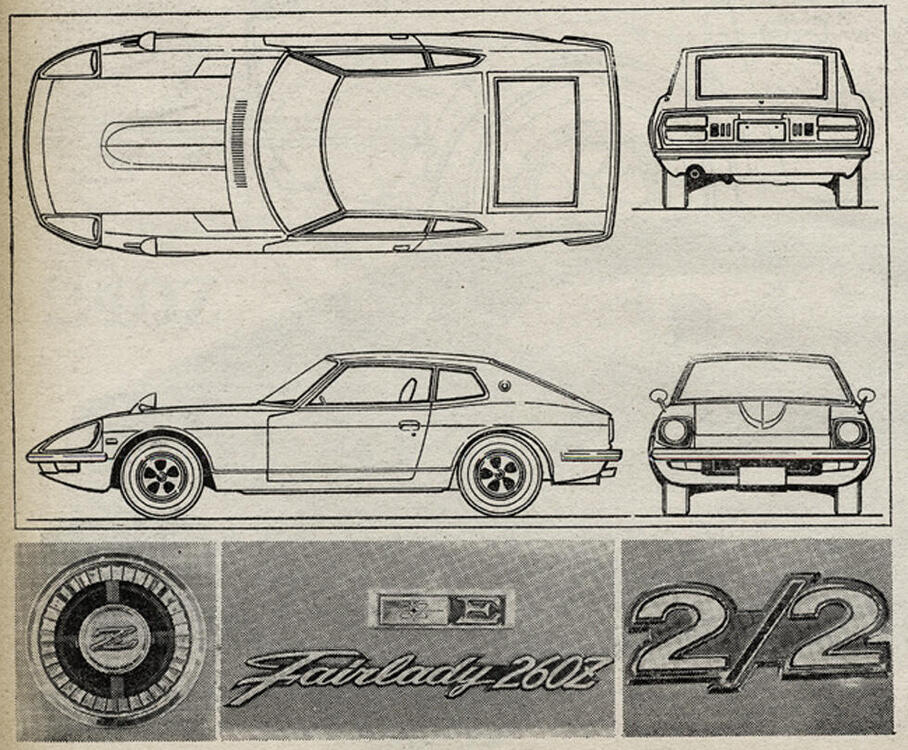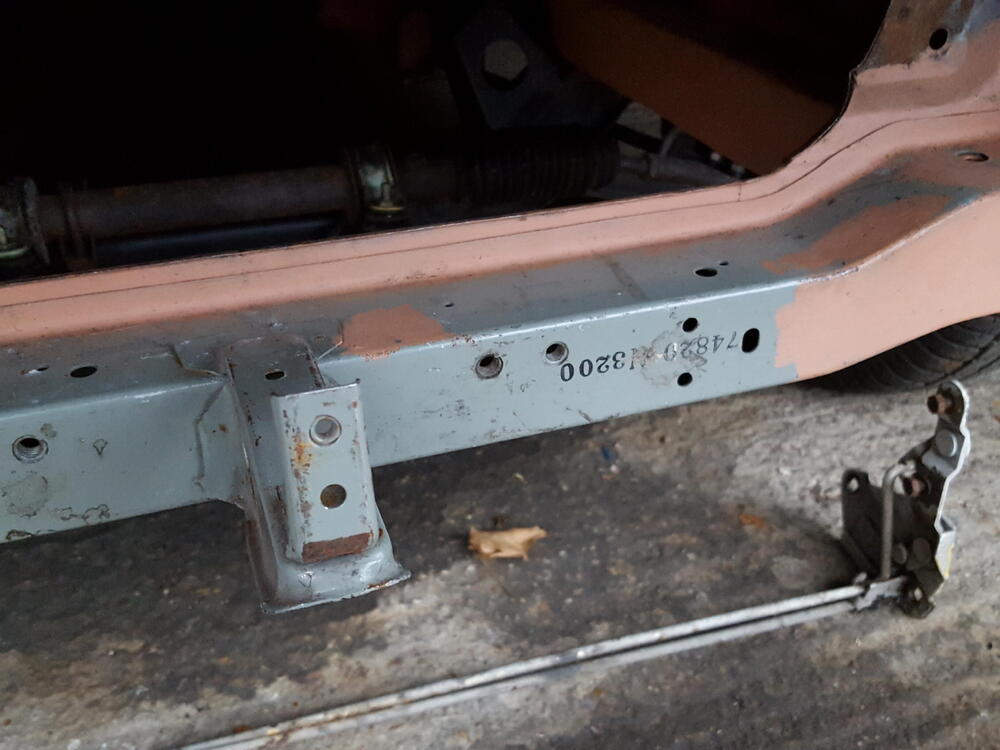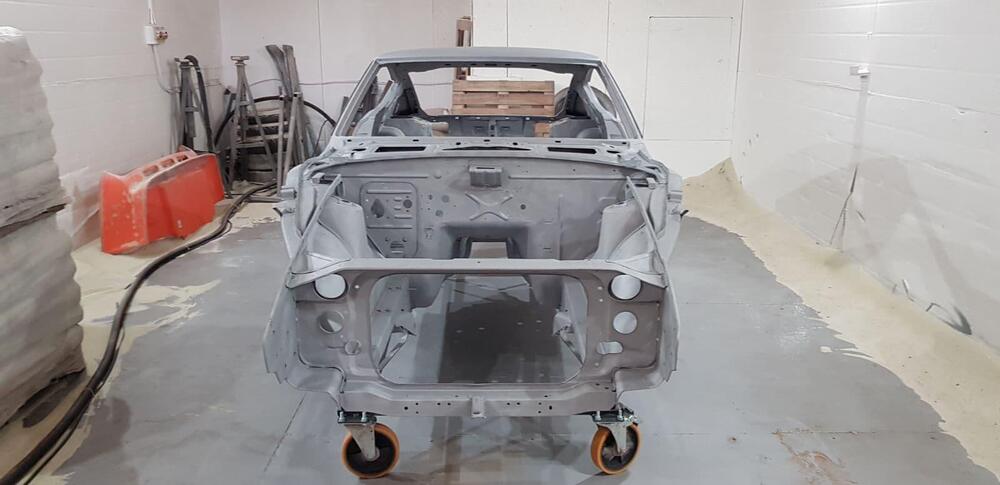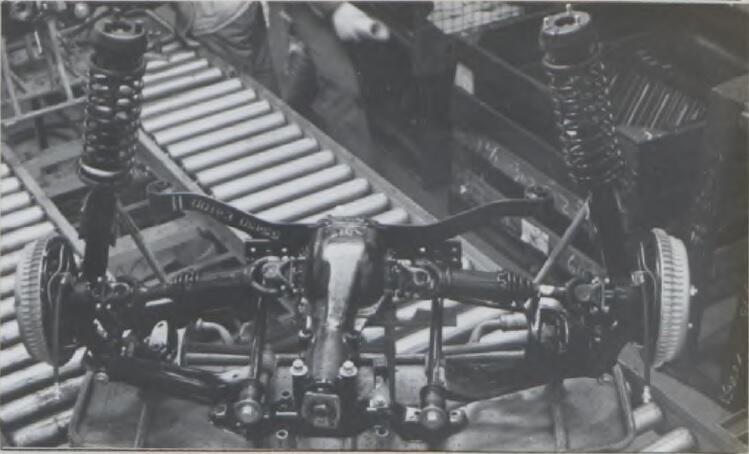Everything posted by HS30-H
-
Help ID brake calipers
YJ auction vendor 'velo1955z' is VintageCraft e-za, the manufacturer of the stainless steel MK63 seal retainer rings and one of those classic one-man-band Japanese craftsmen. Great guy and a fellow member of Club S30 Japan. He makes all sorts of other interesting stuff too. https://www.vintagecraft-e-za.com/ I'm not aware of any other people who make the retainer rings in stainless steel. They are a boon as they don't rust and can survive multiple re-use, unlike the originals.
-
Help ID brake calipers
Part No.4 on the diagram are the steel rings which retain the rubber dust seals (Part No.5) in the caliper halves. The rings are a tight push fit in the caliper casting, leaving a lip around which the dust seals grip. In this way the dust seals remain fixed in one place and the pistons are free to move past them. Wire spring clips retaining the dust seals do not sound like original parts and may in fact be the work of a previous owner? The original steel retaining rings tend to rust over time and - in some cases - can all too easily get damaged/deformed when being removed. A previous rebuild/seal replacement may have forced some improvisation? In any case, you do need the correct seal retainer rings as without them the seals are going to move away from the caliper casting as the pistons operate, uncovering the gap between the pistons and the caliper castings. They won't last long like that...
-
Help ID brake calipers
Before you go to that trouble, check out your national suppliers of old Jaguar parts (mossmotors.com for one) and investigate caliper bleed screws for the Girling-Dunlop brakes used on 50s and 60s models such as the MK.1 through Mk.10, XK150 and early E-Type. The Sumitomo MK63 licensed a number of Girling-Dunlop patent designs which also used the ball-bearing type bleed screw system. Larger bored master cylinders are not required. I have used both solid rotor and vented rotor type MK63 calipers on many of my cars over the years (still use them on four current cars) and I always use the stock 7/8" master cylinder. I even use the 7/8" bore on my 432-R replica with its Master Vac delete (pedal motion ratio is modified) and they work well. Nissan's own recommendation was to use stock MC. A friend over here fitted a Wilwood 1" MC on his rally 240Z with vented rotor type MK63s and found that it gave a high and firm pedal feel but was hard to use. Switched back to a stock 7/8" MC which I supplied to him and he was MUCH happier.
-
L24 Battles Six S20's. Guess who wins?
LOL. A somewhat inevitable LIKE for a comment in support of a thread that has required too many corrections to count. I very much doubt that our friend 268Z has any idea just how badly misconceived, ill-informed and just plain wrong the original post was, let alone how much it has been quietly edited to cover much of that up. If there was any patience, poise or level-headedness in this thread it certainly wasn't in the first post...
-
Odd Bolts in Balance Tube
-
Help ID brake calipers
Here's the pad data. You have the NON-VENTED (solid rotor, narrow caliper) type with the cutaway shape. I have a vague recollection that there's a Ford pad (Capri?) which is very close and only requires a little trimming around the edges to fit and work safely. Worth asking your brake supplier if they can come up with something that has these dimensions. I'll include the VENTED rotor type data for completeness, but the pads are not interchangeable.
-
L24 Battles Six S20's. Guess who wins?
That's his Tinder profile sorted. The corrections, clarifications and context are free. Your servant, Sir! More accurately, an LR24 riding in a PS30-SB's body whilst also using 95% of its drivetrain. Nissan's Works race team "won that day".
-
Help ID brake calipers
You mentioned a damaged bleeder thread in your first post. I think it might be wise to establish whether there's an issue with the corresponding thread in the caliper casting or not before they can be assessed for value.
-
Help ID brake calipers
Very likely - if not certain - to have been purchased from Datsun Competition USA as an aftermarket street tuning upgrade. Elsewhere in the world they were available - in both solid (stock) rotor and vented rotor form - via Nissan Sports from 1969 and, after 1984, NISMO. MK63 calipers were the period FIA and JAF homologated race and rally option for 'our' cars. Nissan used them on their Works competition cars.
-
Help ID brake calipers
I concur Ian. Jeff has a pair of solid rotor type (narrow) Sumitomo MK63 4-pot calipers, complete with the correct mounting kit - identifiable via the alloy plumbing elbows and flexi pipes. Your early Sumitomo MK63s use the Dunlop style ball-bearing bleed nipples (the bleed nipple 'squashes' a small BB against a small hole in the caliper to seal it) and there's a reverse dome on the end of the nipple to assist this. Swapping in an ordinary M10 1.0 valve won't do.
-
Z's on BAT and other places collection
Hitoshi Uemura told me that the vented quarter panel design update saved both manufacturing time and parts costs, deleting the complex vents & drains in the tailgate which were made up of many individual components and which took time to assemble. The vented quarters function was pretty much achieved at the metal stamping and spotwelding stage, with just a push-on vent/emblem on the outside (popped on after paint) and simple holes in the hard plastic interior trim. A neat solution.
-
Z's on BAT and other places collection
With all due respect to you, I think the main question here starts from a mistaken premise. The whole 'Series One', 'Series Two' ('Series 1.5' LOL) thing implies hard change points onto which have been hung big assumptions. People have tended to believe that the big production change points (EG vented tailgate to vented quarter) also included a raft of other content/spec changes. But if you look at the wider story of the whole S30-series Z family, you can observe changes being made all the way through production. The Japanese market variants in particular were going through a constant process of evolution in specs and componentry. So much so that it is hard to track them all. Yes, some of the major changes coincided and were obviously planned to happen at points when updates to new regulations were being complied with, but evolution was going on all the way through production and for many different reasons. As an example, here in the UK I have often heard people talking and writing about early production UK market RS30 '260Z' models as being made with many "left over" HS30 '240Z' parts. It's as though they imagined Nissan having warehouses full of '240Z' parts which somehow needed to be "used up" before the switch over to 'real 260Z' parts. This is - of course - a simple and innocent misapprehension. In trying to make sense of what they observed on the cars as-delivered they came up with an imaginary scenario which did not reflect the wider reality. All they were observing was ongoing evolution in componentry either side of a major update (the switch from HS30 '240Z' to RS30 '260Z'). The expectation was that the 'new model' switch should indicate all new content. Some of it was, but a lot of it wasn't. So, for example, we hear about early 260Zs with '240Z' doors and '240Z' struts etc as though old parts are being used up before the switchover to newer specs. You'd kind of hope that Nissan had a better grip on their parts production than that, no? I'd be surprised if a lot of this doesn't come from expectations based on the activities of the major American manufacturers, and that being applied - mistakenly - to a Japanese manufacturer. Perhaps American and Canadian car buyers had got so used to the 'Model Year' updates of their domestic manufacturers that they expected Nissan to behave in the same way? The fact is that in some ways they did, but in others they did not. Hence the confusion?
-
Z's on BAT and other places collection
I think some of us find it strained rather than offensive. It attempts to put somewhat square pegs in neat, round holes. Yes, I can see how it came about and yes, I can see that some kind of lines in the sand would be useful (I tend to think along the lines of 'solid pillar/vented pillar' and then 'A-trans/B-trans' and so on) but trying to define spec/content - and that's exactly when it gets used - by citing a fairly arbitrary idea of 'Series' is soon going to get tripped up. And yes, it does get used as though it is a hard and fast rule/absolute (see post #2637 of this thread...!) and reinforced by people who are often cited as authorities on the cars. Self-certification.
-
Z's on BAT and other places collection
Presumably it will be explained away with the usual goalpost moving and assigned some fraction between 1 and 2 ('Series 1.25'/'Series 1.5'/'Series 1.75'). Solito Negotium. I'm sorry but all this 'using up of stock parts until depleted' narrative is a combination of supposition, underestimation of Nissan as a company and lack of knowledge about what was actually going on. It implies that Nissan's component manufacturing - both in-house and with sub-contractors - was somehow disconnected with the sections of the company engaged in planning model updates and supersessions of said components. The idea that Nissan would find themselves with crates full of suddenly obsolescent parts which somehow needed to be "used up" before the introduction of their successors is for the birds. This is Cargo Cult-level nonsense. Jungle tribes trying to make sense of refrigerators dropping out of the sky. Much like the retrospectively-applied vernacular 'Series' appellations, indeed. Pundits need to do better. Have to laugh at the list of de-merits for this car cited as reasons why it won't be bid as high as last time. Those 'faults' (hey, it's had a life, who knew?) were on the car last time it was bid sky high too. The car hasn't changed, the zeitgeist has.
-
Z's on BAT and other places collection
Deal breaker. That'll eliminate the 'Serious Collectors' (TM). 🙃
-
Finally found a 69 240z, #51 Time to finish a 30 year multiple owner restoration.
Indeed. And after dressing and painting nobody would know they were ever there.
-
Finally found a 69 240z, #51 Time to finish a 30 year multiple owner restoration.
Well your memory is obviously much better than mine Kats, as I had completely forgotten about that. So the N3200 was part of the aborted Fairlady 260Z-E project... ...and the airbox mount is correct. Fascinating to think that some of the specific parts made it into Nissan's spare parts system. As mentioned, my white 240ZG project car needed a radiator support crossmember (due to old damage) and the only panel I could find at the time was the same 74820-N3200 as David has. I just removed the unneeded additions. Think it worked OK. David, can you do something like this for your N3200?
-
Finally found a 69 240z, #51 Time to finish a 30 year multiple owner restoration.
The mount for the 432 airbox is on the wrong side (factory mistake?), but the holes for the H-H 'Traction Hook' are correct. N3200 ink stamp part number? I think it was a generic one-size-fits-all interim service part just before the version with the aircon condenser-related horn mounts. I used one for my white H-H and I had to cut the 432 airbox mount off (although it was on the correct side). Worked OK. I think you'd struggle to find an NOS E4200 or E4201 version.
-
Finally found a 69 240z, #51 Time to finish a 30 year multiple owner restoration.
The double stripe in the photo is next to an E4100 part number, so I would imagine it is paired to that in some way. As mentioned up-thread, E4100 was listed for the S30-prefixed Standard Fairlady Z and Deluxe Fairlady Z-L models up to chassis number S30-00976 (at which point they switched to the E4101). PS30-prefixed Fairlady Z432 and Fairlady Z432-R got the E4200 from the beginning of production and switched to E4201 at PS30-00103, so I doubt they would have double stripes too. When we see paint stripe colour identifications on these cars (such as seen on springs, for example) it usually seems intended to identify parts that are in parallel use, and would help in avoidance of mistaken fitment. I think the large and prominent stencilling of the full part number on the moustache bars is significant in that respect, as Nissan were using the E4100 and E4200 in parallel on at least two different variants and their sub-variants. It seems as though the E4101 may have been in that mix too for the Export models, so I'm imagining a situation on the assembly lines where that large white part number and the stripe(s) also helped identify a complete assembled rear end 'module' on the jig (as pictured) before lifting and fitment into a painted body. Would be interested to hear other opinions on that.
-
Finally found a 69 240z, #51 Time to finish a 30 year multiple owner restoration.
Just as an aside, here's an E4100 - with double stripes - on the factory floor as part of a rear end 'module' ready to be installed. Early photo:
-
Finally found a 69 240z, #51 Time to finish a 30 year multiple owner restoration.
I saw E4101 in the USA & Canada catalogue too, but wondered if the E4100 was superseded so soon on the HLS30s that it wasn't listed. It certainly ranks as a very early part number change. I wonder what was different? Musings for another thread I guess...
-
Finally found a 69 240z, #51 Time to finish a 30 year multiple owner restoration.
Not E4100? In the first Japanese market parts manual (pub. C-137) they list 55450-E4100 first for the S and D models, superseded by the E4101 at S30-00976. That would be around January 1970? S20-engined models first got the E4200, which was superseded with the E4201 at PS30-00103. I would imagine both supersessions were likely to be NVH-related improvements?
-
My Datsun 240Z
-
My Datsun 240Z
Very likely to be from an original European market variant pairing, yes? Have you got the correct double-flanged sliding-joint propeller shaft to join the two together?
-
My Datsun 240Z
As standard equipment on the S30-series Z range, FS5C71-A was usually paired with 3.9:1 ratio R180 in all markets except USA & Canada (including Japan). It was also paired with 4.44:1 ratio R192 LSD on Japanese market PS30 Fairlady Z432 and PS30-SB Fairlady Z432-R.








